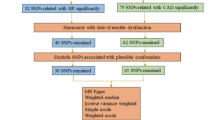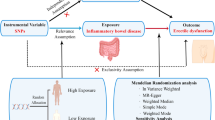Abstract
Purpose
Erectile dysfunction (ED) often appears concomitantly with cardiovascular diseases (CVDs). However, the causal relationship between ED and CVDs is still unclear. This study aimed to investigate the causal effects between CVDs and ED using bidirectional Mendelian randomization (MR).
Methods
ED data (6175 cases and 217,630 controls) were obtained from the IEU OpenGWAS project. Seven types of CVDs were acquired in our study, including stroke (Sample size = 440,328), myocardial infection (Sample size = 184,305), coronary heart disease (Sample size = 86,995), hypertension (Sample size = 36,683), heart failure (Sample size = 208,178), atrial fibrillation (Sample size = 1,030,836), and coronary artery disease (Sample size = 141,217). Inverse variance weighted (IVW) was selected as the primary method for MR analysis.
Results
IVW results indicated that stroke (OR = 1.14, 95% CI = 1.02–1.29, P = 0.025), coronary artery disease (OR = 1.09, 95% CI = 1.02–1.16, P = 0.013), coronary heart disease (OR = 1.07, 95% CI = 1.01–1.13, P = 0.017), myocardial infection (OR = 1.09, 95% CI = 1.02–1.17, P = 0.011), and atrial fibrillation (OR = 1.06, 95% CI = 1.00–1.12, P = 0.04) were causally associated with ED. The reverse MR analysis suggested that ED did not influence the prevalence of CVDs.
Conclusion
These findings highlighted CVDs as causal risk factors for ED, but ED did not directly result in the development of CVDs. Regular monitoring of the erectile function of individuals with CVDs, along with implementing appropriate preventive measures, might help reduce the incidence of ED and enhance the sexual well-being of patients with CVDs.



Similar content being viewed by others
Availability of data and materials
All data could be obtained from the publicly available IEU OpenGWAS Project (https://gwas.mrcieu.ac.uk/).
References
Wang TD, Lee CK, Chia YC, Tsoi K, Buranakitjaroen P et al (2021) Hypertension and erectile dysfunction: the role of endovascular therapy in Asia. J Clin Hypertens (Greenwich) 23:481–488
Yafi FA, Jenkins L, Albersen M, Corona G, Isidori AM et al (2016) Erectile dysfunction. Nat Rev Dis Primers 2:16003
Rew KT, Heidelbaugh JJ (2016) Erectile dysfunction. Am Fam Physician 94:820–827
Chen L, Shi GR, Huang DD, Li Y, Ma CC et al (2019) Male sexual dysfunction: a review of literature on its pathological mechanisms, potential risk factors, and herbal drug intervention. Biomed Pharmacother 112:108585
Elyamani R, Soulaymani A, Hami H (2021) Epidemiology of cardiovascular diseases in Morocco: a systematic review. Rev Diabet Stud 17:57–67
Shamloul R, Ghanem H (2013) Erectile dysfunction. Lancet 381:153–165
Durukan E, Jensen CFS, Skaarup KG, Ostergren PB, Sonksen J et al (2023) Erectile dysfunction is associated with left ventricular diastolic dysfunction: a systematic review and meta-analysis. Eur Urol Focus. https://doi.org/10.1016/j.euf.2023.06.001
Inman BA, Sauver JL, Jacobson DJ, McGree ME, Nehra A et al (2009) A population-based, longitudinal study of erectile dysfunction and future coronary artery disease. Mayo Clin Proc 84:108–113
Rinkuniene E, Gimzauskaite S, Badariene J, Dzenkeviciute V, Kovaite M et al (2021) The prevalence of erectile dysfunction and its association with cardiovascular risk factors in patients after myocardial infarction. Medicina (Kaunas) 57:1103
Eaton CB, Liu YL, Mittleman MA, Miner M, Glasser DB et al (2007) A retrospective study of the relationship between biomarkers of atherosclerosis and erectile dysfunction in 988 men. Int J Impot Res 19:218–225
Platek AE, Hrynkiewicz-Szymanska A, Kotkowski M, Szymanski FM, Syska-Suminska J et al (2016) Prevalence of erectile dysfunction in atrial fibrillation patients: a cross-sectional, Epidemiological Study. Pacing Clin Electrophysiol 39:28–35
Dai H, Wang J, Zhao Q, Ma J, Gong X et al (2020) Erectile dysfunction and associated risk factors in male patients with ischemic stroke: a cross-sectional study. Medicine (Baltimore) 99:e18583
Wang XY, Huang W, Zhang Y (2018) Relation between hypertension and erectile dysfunction: a meta-analysis of cross-section studies. Int J Impot Res 30:141–146
Imprialos K, Koutsampasopoulos K, Manolis A, Doumas M (2021) Erectile dysfunction as a cardiovascular risk factor: time to step up? Curr Vasc Pharmacol 19:301–312
Carter AR, Sanderson E, Hammerton G, Richmond RC, Davey Smith G et al (2021) Mendelian randomisation for mediation analysis: current methods and challenges for implementation. Eur J Epidemiol 36:465–478
Bovijn J, Jackson L, Censin J, Chen CY, Laisk T et al (2019) GWAS identifies risk locus for erectile dysfunction and implicates hypothalamic neurobiology and diabetes in etiology. Am J Hum Genet 104:157–163
Malik R, Chauhan G, Traylor M, Sargurupremraj M, Okada Y et al (2018) Multiancestry genome-wide association study of 520,000 subjects identifies 32 loci associated with stroke and stroke subtypes. Nat Genet 50:524–537
Nielsen JB, Thorolfsdottir RB, Fritsche LG, Zhou W, Skov MW et al (2018) Biobank-driven genomic discovery yields new insight into atrial fibrillation biology. Nat Genet 50:1234–1239
Schunkert H, Konig IR, Kathiresan S, Reilly MP, Assimes TL et al (2011) Large-scale association analysis identifies 13 new susceptibility loci for coronary artery disease. Nat Genet 43:333–338
Nikpay M, Goel A, Won HH, Hall LM, Willenborg C et al (2015) A comprehensive 1,000 genomes-based genome-wide association meta-analysis of coronary artery disease. Nat Genet 47:1121–1130
Burgess S, Thompson SG, Collaboration CCG (2011) Avoiding bias from weak instruments in Mendelian randomization studies. Int J Epidemiol 40:755–764
Holmes MV, Ala-Korpela M, Smith GD (2017) Mendelian randomization in cardiometabolic disease: challenges in evaluating causality. Nat Rev Cardiol 14:577–590
Bowden J, Davey Smith G, Burgess S (2015) Mendelian randomization with invalid instruments: effect estimation and bias detection through Egger regression. Int J Epidemiol 44:512–525
Hemani G, Zheng J, Elsworth B, Wade KH, Haberland V et al (2018) The MR-Base platform supports systematic causal inference across the human phenome. Elife. https://doi.org/10.7554/eLife.34408
Bowden J, Spiller W, Del Greco MF, Sheehan N, Thompson J et al (2018) Improving the visualization, interpretation and analysis of two-sample summary data Mendelian randomization via the Radial plot and Radial regression. Int J Epidemiol 47:1264–1278
Verbanck M, Chen CY, Neale B, Do R (2018) Detection of widespread horizontal pleiotropy in causal relationships inferred from Mendelian randomization between complex traits and diseases. Nat Genet 50:693–698
Guo W, Liao C, Zou Y, Li F, Li T et al (2010) Erectile dysfunction and risk of clinical cardiovascular events: a meta-analysis of seven cohort studies. J Sex Med 7:2805–2816
Chiurlia E, D’Amico R, Ratti C, Granata AR, Romagnoli R et al (2005) Subclinical coronary artery atherosclerosis in patients with erectile dysfunction. J Am Coll Cardiol 46:1503–1506
Kalka D, Gebala J, Biernikiewicz M, Mrozek-Szetela A, Rozek-Piechura K et al (2021) Erectile dysfunction in men burdened with the familial occurrence of coronary artery disease. J Clin Med 10:4046
Montorsi F, Briganti A, Salonia A, Rigatti P, Margonato A et al (2003) Erectile dysfunction prevalence, time of onset and association with risk factors in 300 consecutive patients with acute chest pain and angiographically documented coronary artery disease. Eur Urol 44:360–364 (discussion 4-5)
Shi H, Zhang FR, Zhu CX, Wang S, Li S et al (2007) Incidence of changes and predictive factors for sexual function after coronary stenting. Andrologia 39:16–21
Wabrek AJ, Burchell RC (1980) Male sexual dysfunction associated with coronary heart disease. Arch Sex Behav 9:69–75
Compostella L, Compostella C, Truong LV, Russo N, Setzu T et al (2017) History of erectile dysfunction as a predictor of poor physical performance after an acute myocardial infarction. Eur J Prev Cardiol 24:460–467
Zhao S, Wu W, Wu P, Ding C, Xiao B et al (2021) Significant increase of erectile dysfunction in men with post-stroke: a comprehensive review. Front Neurol 12:671738
Winder K, Seifert F, Kohrmann M, Crodel C, Kloska S et al (2017) Lesion mapping of stroke-related erectile dysfunction. Brain 140:1706–1717
Koehn J, Crodel C, Deutsch M, Kolominsky-Rabas PL, Hosl KM et al (2015) Erectile dysfunction (ED) after ischemic stroke: association between prevalence and site of lesion. Clin Auton Res 25:357–365
Terentes-Printzios D, Ioakeimidis N, Rokkas K, Vlachopoulos C (2022) Interactions between erectile dysfunction, cardiovascular disease and cardiovascular drugs. Nat Rev Cardiol 19:59–74
Gandaglia G, Briganti A, Montorsi P, Mottrie A, Salonia A et al (2016) Diagnostic and therapeutic implications of erectile dysfunction in patients with cardiovascular disease. Eur Urol 70:219–222
De Leonardis F, Colalillo G, Finazzi Agro E, Miano R, Fuschi A et al (2022) Endothelial dysfunction, erectile deficit and cardiovascular disease: an overview of the pathogenetic links. Biomedicines 10:8–1848
Muneer A, Kalsi J, Nazareth I, Arya M (2014) Erectile dysfunction. BMJ 348:g129
Funding
This work was supported by the National Natural Science Foundation of China (No. 82001740).
Author information
Authors and Affiliations
Contributions
SXZ and YJX conceived and designed the analysis; YJX, XYY, and JZ performed the analysis; SXZ, YJX, RTS and LKQ wrote the manuscript; SXZ and YJX reviewed the manuscript.
Corresponding author
Ethics declarations
Conflicts of interest
All authors declare no competing interests.
Research involving Human Participants and/or Animals
Not applicable.
Informed consent
Not applicable.
Additional information
Publisher's Note
Springer Nature remains neutral with regard to jurisdictional claims in published maps and institutional affiliations.
Rights and permissions
Springer Nature or its licensor (e.g. a society or other partner) holds exclusive rights to this article under a publishing agreement with the author(s) or other rightsholder(s); author self-archiving of the accepted manuscript version of this article is solely governed by the terms of such publishing agreement and applicable law.
About this article
Cite this article
Xi, Y., Yin, X., Zhou, J. et al. Genetically predicted cardiovascular diseases could increase the risk of erectile dysfunction: a bidirectional Mendelian randomization. World J Urol 41, 3187–3194 (2023). https://doi.org/10.1007/s00345-023-04630-6
Received:
Accepted:
Published:
Issue Date:
DOI: https://doi.org/10.1007/s00345-023-04630-6




